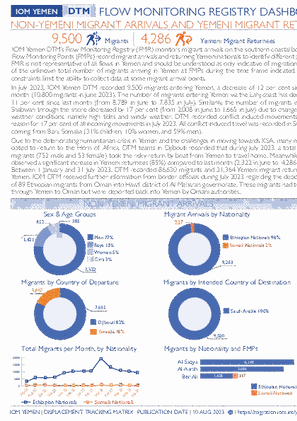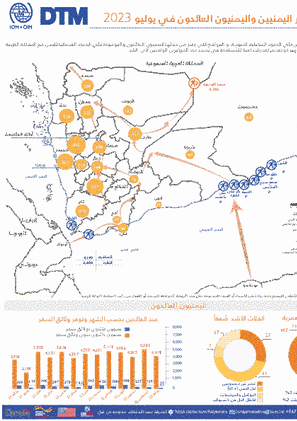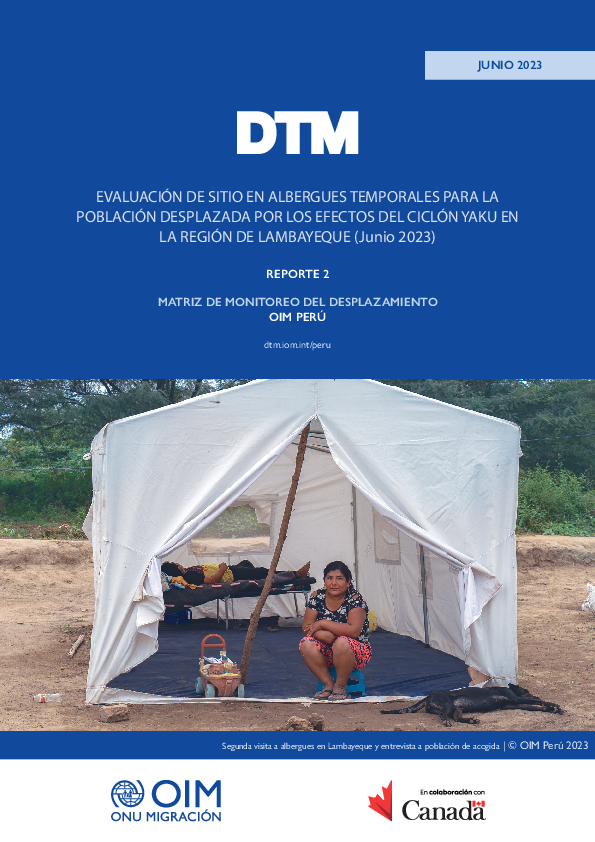-
Countries
-
Data and Analysis
-
Special Focus
-
Crisis Responses
Contact
DTM Ethiopia, DTMEthiopia@iom.int
Location
Ethiopia
Activity
- Mobility Tracking
- Site Assessment
- Village Assessment
Period Covered
Jun 10 2023 -Jun 26 2023
In June 2023, IOM DTM deployed the Village Assessment Survey (VAS) Round 16 (figure update) in 64 villages across Afar, Amhara, Oromia, SNNP and South West Ethiopia Peoples' regions of Ethiopia. The VAS Round 15 data (November 2022 - January 2023) was compiled with the figure update VAS Round 16 (June 2023) data to develop a national returning IDP figure updated to June 2023 for 1,791 villages, excluding Tigray region. The villages assessed during both Round 15 and Round 16 are not duplicated in the consolidated figure.
As of June 2023, IOM DTM estimated 1,982,506 returning IDPs (441,644 returning IDP households) across 1,791 assessed, accessible villages in Ethiopia, excluding Tigray region. The data for Tigray region is shared separately.
Population Groups
Survey Methodology
Unit of Analysis Or Observation
Type of Survey or Assessment
Keywords
Geographical Scope
Administrative boundaries with available data
The current dataset covers the following administrative boundaries
Contact
DTM Ethiopia, DTMEthiopia@iom.int
Location
Ethiopia
Activity
- Mobility Tracking
- Site Assessment
Period Covered
Jun 11 2023 -Jun 29 2023
In June 2023, IOM DTM deployed Site Assessment (SA) Round 33 (figure update) in 281 sites across Afar, Amhara, Oromia, Sidama, SNNP and Somali regions of Ethiopia. The SA Round 32 data (November 2022 - January 2023) was compiled with the figure update SA Round 33 (June 2023) data to develop a national IDP figure updated to June 2023 for 2,750 sites, excluding Tigray region. The sites assessed during both Round 32 and Round 33 are not duplicated in the consolidated figure.
As of June 2023, 3,363,991 IDPs (622,015 IDP households) were internally displaced across 2,750 accessible sites in Ethiopia, excluding Tigray region. The data for Tigray region is shared separately.
Population Groups
Survey Methodology
Unit of Analysis Or Observation
Type of Survey or Assessment
Keywords
Geographical Scope
Administrative boundaries with available data
The current dataset covers the following administrative boundaries
The Central African Republic (CAR), which has experienced continuous volatility for the past two decades, has been riddled by a crisis which ignited in 2012 with a violent takeover of power and has developed into a complex protracted state of permanent insecurity and fragility which has spilled over into neighbouring countries. The crisis is characterized by power struggles amongst elites, the absence of state institutions and public investment, religious and ethnic tensions and disputes for the control of key resources. More recently, the crisis in Sudan, which started in April 2023, is affecting the eastern part of the CAR witnessing arrivals of displaced populations. As of July 2023, 3,831,877 individuals were affected, including 485,825 internally displaced persons (13% of the displaced population), 2,063,885 returnees former IDPs (54%), 503,019 returnees from abroad (13%) and 779,148 refugees (20%). In the CAR, the largest displaced population consists of former IDP returnees. Refugees from the CAR are primarily hosted by Cameroon (350,428 individuals, or 45% of the refugees), the Democratic Republic of the Congo (DRC) (210,552 individuals, or 27% of the refugees) and Chad (127,934 individuals, or 16% of the refugees). Nonetheless, 24,370 refugees from the Central African Republic are still living in Sudan (3% of the refugees). Since the beginning of the Sudan crisis, a total of 4,071 Central Africans have returned to their country of origin through the border in Am-Dafock, representing 4 per cent of returns from abroad. In addition, the CAR is also home for refugees from neighbouring countries, hosting a total of 33,209 refugees coming from Sudan (22,768 individuals), the DRC (6,384 individuals), South Soudan (2,726 individuals) and Chad (1,331 individuals).
The Central Sahel area, and in particular the Liptako Gourma region, which borders Burkina Faso, Mali and Niger, is affected by a complex crisis involving growing competition over dwindling resources; climatic variability; demographic pressure; high levels of poverty; disaffection and a lack of livelihood opportunities; communal tensions; the absence of state institutions and basic services; and violence related to organized crime and non-state armed groups. The crisis has triggered significant displacement of populations in the concerned countries and is affecting neighbouring countries such as Mauritania and the coastal countries.
As of July 2023, 2,911,228 individuals have been displaced, including 2,614,709 internally displaced persons (90% of the displaced population) and 296,519 refugees (10% of the displaced population). Seventy-two per cent of the displaced populations (2,098,917 individuals) were located in Burkina Faso, while 15 per cent resided in Mali (437,842 individuals), 8 per cent in Niger (233,041 individuals) and 3 per cent in Mauritania (101,844 individuals). The crisis’ recent spill over to coastal countries, namely Côte d’Ivoire, Ghana, Togo and Benin, shows growing number of refugees coming from the Central Sahel and populations internally displaced. As of July, 39,584 individuals were affected by displacement within the four countries (2,293 in Benin, 6,316 in Côte d’Ivoire, 6,598 in Ghana and 24,377 in Togo) of which 10,397 were internally displaced. Other estimations account for 63,831 refugees currently living in the four countries (10,000 in Benin, 25,719 in Côte d’Ivoire, 8,112 in Ghana and 20,000 in Togo).
The crisis currently affecting the Lake Chad Basin states results from a complex combination of factors, including conflict with non-state armed groups, extreme poverty, underdevelopment and a changing climate, which together have triggered significant displacement of populations. As of July 2023, Cameroon, Chad, Niger and Nigeria were hosting an estimated 6,065,751 affected individuals made up of internally displaced persons (IDPs), returnees (former IDPs and returnees from abroad) and refugees (both in- and out-of-camp).

Contact
DTM Europe, DTMMediterranean@iom.int
Language
English
Location
Hungary
Period Covered
Apr 01 2023
Jun 30 2023
Activity
- Survey
- Flow Monitoring
This report is based on IOM’s Displacement Tracking Matrix (DTM) survey of displacement patterns, needs and intentions, conducted in the 11 countries included in the Regional Response Plan for Ukraine in 2023: 6 countries neighboring Ukraine – Belarus, Hungary, Poland, Republic of Moldova, Romania and Slovakia – and other 5 countries particularly impacted by the arrivals of refugees from Ukraine since the start of the war in February 2022 – Bulgaria, Czechia, Estonia, Latvia and Lithuania.
Key Findings:
• Intentions to stay in Hungary: transiting (32%), already settled (24%), planning to settle (19%), residence in Ukraine (15%), residence in another country (8%).
• Applied for Temporary Protection (TP): yes (59%), no (40%). Out of those who have already settled, most registered for TP (84%) or are on a work visa (11%).
• Employment status: employed (19%), unemployed and looking for a job (16%), retired (8%), unemployed and not looking for a job (5%), student (4%).
• Top needs in Hungary:* financial support (51%), transportation (49%), information (40%), long-term accommodation (35%), food (35%), health services (24%).
• Top areas of assistance received:* transportation (80%), food (55%), accommodation (47%). • Top inclusion challenges:* language (53%), financial issue (33%), lack of general information (21%), lack of information on jobs (17%), housing (15%).
* more than one answer possible

Contact
IOM DTM Yemen, iomyemendtm@iom.int
Language
English
Location
Yemen
Period Covered
Aug 01 2023
Aug 31 2023
Activity
- Flow Monitoring
IOM Yemen DTM’s Flow Monitoring Registry (FMR) monitors migrant arrivals on the southern coastal border and Yemeni return locations on Yemen's northern border with the Kingdom of Saudi Arabia (KSA). Enumerators placed at Flow Monitoring Points (FMPs) record migrant arrivals and returning Yemeni nationals to identify different patterns of migration, and to provide quantitative estimates to help define the population of irregular migrants entering the country. FMR is not representative of all flows in Yemen and should be understood as only indicative of migration trends of the unknown total number of migrants arriving in Yemen at FMPs during the time frame indicated. Access constraints limit the ability to collect data at some migrant arrival points.
In July 2023, IOM Yemen DTM recorded 9,500 migrants entering Yemen, a decrease of 12 per cent since last month (10,800 migrants in June 2023). The number of migrants entering Yemen via the Lahj coast has decreased 11 per cent since last month (from 8,789 in June to 7,835 in July). Similarily, the number of migrants entering Shabwah through the shore decreased by 17 per cent (from 2,008 in June to 1,665 in July) due to changes in the weather conditions, namely high tides and windy weather. DTM recorded conflict induced movements as the reason for 17 per cent of all incoming movements in July 2023. All conflict induced travel was recorded in Shabwah coming from Bari, Somalia (31% children, 10% women, and 59% men).
Due to the deteriorating humanitarian crisis in Yemen and the challenges in moving towards KSA, many migrants opted to return to the Horn of Africa. DTM teams in Djibouti recorded that during July 2023, a total of 805 migrants (752 male and 53 female) took the risky return by boat from Yemen to travel home. Meanwhile, DTM observed a significant increase in Yemeni returnees (85%) compared to last month (2,322 in June to 4,286 in July). Between 1 January and 31 July 2023, DTM recorded 86,630 migrants and 31,364 Yemeni migrant returnees to Yemen. IOM DTM received further information from border officials during July 2023 regarding the deportation of 89 Ethiopian migrants from Oman into Hawf district of Al Maharah governorate. These migrants had travelled through Yemen to Oman but were deported back into Yemen by Omani authorities.

Contact
IOM DTM Yemen, iomyemendtm@iom.int
Language
English
Location
Yemen
Period Covered
Jul 01 2023
Jul 31 2023
Activity
- Flow Monitoring
تعمل مصفوفة تتبُع النزوح الخاصة بالمنظمة الدولية للهجرة في اليمن عبر سجل مراقبة التدفق في المواقع الرئيسية التي يصل عبرها المهاجرون على الحدود الساحلية الجنوبية، و المواقع التي يعبر من خلالها اليمنيون العائدون والموجودة على الحدود الشمالية لليمن مع المملكة العربية السعودية. يُراقب الباحثون المتمركزون في نقاط رصد تدفق وصول المهاجرين والمواطنين اليمنيين العائدين من أجل التعرف على الأنماط المختلفة للهجرة وتقديم تقديرات كمية للمساهمة في تحديد عدد المهاجرين الوافدين الى البلد.
لا يشمل سجل مراقبة التدفق جميع نقاط التدفق في اليمن، ولكنه يمثل مؤشراً حول اتجاهات الهجرة بالنسبة لإجمالي العدد غير المعروف للمهاجرين الوافدين إلى اليمن عبر نقاط التدفق خلال الإطار الزمني المحدد. والجدير بالذكر أن القيود المفروضة على الوصول تَحُد من القدرة على جمع البيانات في بعض نقاط وصول المهاجرين.
لاحظت مصفوفة تتبع النزوح التابعة للمنظمة الدولية للهجرة في اليمن دخول 9,500 مهاجر إلى اليمن في يوليو 2023 ، بانخفاض قدره 12٪ عن الشهر السابق (10,800 مهاجرًا في يونيو 2023). سجلت مصفوفة تتبع النزوح انخفاضاً بنسبة 11٪ في عدد الوافدين إلى لحج (7,835 مهاجرًا) مقارنة بالشهر السابق (8,789). وبالمثل ، انخفض عدد المهاجرين الوافدين عبر ساحل شبوة (- 17٪) (من 2،008 في يونيو إلى 1،665 في يوليو) بسبب التغيرات في الأحوال الجوية مما أدى إلى صعوبة التنقل في المد والجزر والرياح القوية. في يوليو 2023 ، وثقت مصفوفة تتبع النزوح الحركات الناجمة عن الصراع باعتبارها سبب 17٪ من جميع الحركات القادمة. تم تسجيل جميع الرحلات المتعلقة بالنزاع والقادمة من باري، الصومال في محافظة شبوة (31٪ أطفال ، 10٪ نساء، و 59٪ رجال).
بسبب الوضع الإنساني المتنامي في اليمن وصعوبة الوصول إلى المملكة العربية السعودية ، يختار العديد من المهاجرين العودة إلى القرن الأفريقي. لاحظ موظفو مصفوفة تتبع النزوح في جيبوتي أن 547 مهاجرًا (532 ذكرًا و 15 أنثى) أخذوا رحلة العودة المحفوفة بالمخاطر بالقارب من اليمن للعودة إلى الوطن خلال يوليو 2023. وفي الوقت نفسه ، لاحظت مصفوفة تتبع النزوح ارتفاعاً كبيرًا في عدد اليمنيين العائدين 85٪) مقارنة بالشهر الماضي (من 2,322 في يونيو إلى 4,286 في يوليو). مابين الفترة من 1 يناير إلى 31 يوليو 2023 ، وثقت مصفوفة تتبع النزوح عدد 86,630 مهاجراً و 31,364 عائداً يمني. كما تلقت مصفوفة تتبع النزوح خلال شهر يوليو 2023، مزيدًا من المعلومات من مسؤولي الحدود اليمنية العمانية حول ترحيل 89 مهاجراً اثيوبياً من عمان إلى منطقة حوف بمحافظة المهرة. كان هؤلاء المهاجرون قد شقوا طريقهم من اليمن إلى عمان.
Contact
iomyemendtm@iom.int
Location
Yemen
Activity
- Flow Monitoring Survey
- Flow Monitoring
Period Covered
Jul 01 2023 -Jul 31 2023
In July 2023, IOM Yemen DTM recorded 9,500 migrants entering Yemen, a decrease of 12 per cent since last month (10,800 migrants in June 2023). The number of migrants entering Yemen via the Lahj coast has decreased 11 per cent since last month (from 8,789 in June to 7,835 in July). Similarily, the number of migrants entering Shabwah through the shore decreased by 17 per cent (from 2,008 in June to 1,665 in July) due to changes in the weather conditions, namely high tides and windy weather. DTM recorded conflict induced movements as the reason for 17 per cent of all incoming movements in July 2023. All conflict induced travel was recorded in Shabwah coming from Bari, Somalia (31% children, 10% women, and 59% men).
Due to the deteriorating humanitarian crisis in Yemen and the challenges in moving towards KSA, many migrants opted to return to the Horn of Africa. DTM teams in Djibouti recorded that during July 2023, a total of 805 migrants (752 male and 53 female) took the risky return by boat from Yemen to travel home. Meanwhile, DTM observed a significant increase in Yemeni returnees (85%) compared to last month (2,322 in June to 4,286 in July). Between 1 January and 31 July 2023, DTM recorded 86,630 migrants and 31,364 Yemeni migrant returnees to Yemen. IOM DTM received further information from border officials during July 2023 regarding the deportation of 89 Ethiopian migrants from Oman into Hawf district of Al Maharah governorate. These migrants had travelled through Yemen to Oman but were deported back into Yemen by Omani authorities.
Population Groups
Survey Methodology
Unit of Analysis Or Observation
Type of Survey or Assessment
Keywords
Geographical Scope
Administrative boundaries with available data
The current dataset covers the following administrative boundaries

Contact
IOMPERUDTM@iom.int
Language
Spanish
Location
Peru
Period Covered
May 25 2023
Jun 16 2023
Activity
- Mobility Tracking
- Site Assessment
Según el Centro de Operaciones de Emergencia Nacional (COEN) del Instituto Nacional de Defensa Civil (INDECI, 2023), a mayo de 2023, el gobierno peruano reportó más de 586.000 personas afectadas3, 96.322 personas damnificadas y 36.298 viviendas destruidas o inhabilitadas. A junio de 2023, estas cifras continuaron al alza, registrándose más de 656.000 personas afectadas, 109.027 personas damnificadas y más de 41.000 viviendas destruidas o inhabilitadas.
A ello se sumó la ampliación de la emergencia sanitaria por 120 días, en mayo de 2023, por el récord de casos reportados por dengue. Según el Centro Nacional de Epidemiología, Prevención y Control de Enfermedades (DGE Perú, 2023)8, a junio de 2023, se registraban 98.760 casos de dengue en el Perú, siendo Lambayeque una de las regiones con más casos y mayor probabilidad de albergar enfermedades respiratorias y diarreicas agudas, infecciones de piel, trastornos psicológicos, afecciones crónicas, dengue y leptospirosis.
En respuesta a este contexto, la Organización Internacional para las Migraciones (OIM) presenta la segunda ronda de la Matriz de Seguimiento de Desplazamiento (DTM por sus siglas en inglés) bajo su componente Evaluación de sitio en albergues temporales en la región de Lambayeque, a fin de recopilar información sobre el estado y necesidades de los albergues en esta segunda visita a los albergues, considerando que, entre la primera y segunda visita a los albergues, hubo un periodo de tiempo de 15 días.


